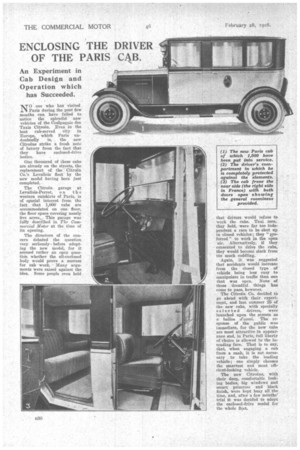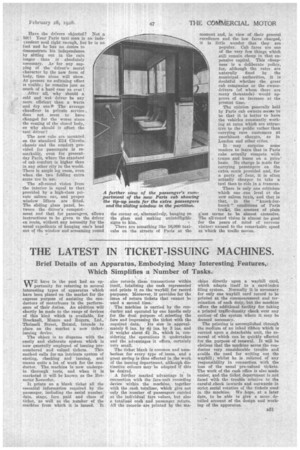ENCLOSING THE DRIVER OF THE PARIS CAB.
Page 56

Page 57

If you've noticed an error in this article please click here to report it so we can fix it.
An Experiment in Cab Design and Operation which has Succeeded.
NO one who has visited Paris during the past few months can have failed to notice the splendid new vehicles of the Corfipmmie des Taxis Citroen. ,Eyen in the best cab-served city in Europe, which Paris undoubtedly is, the new Citroens strike a fresh note of luxury from the fact that they have enclosed-drive bodies.
One thousand of these cabs are already on the streets, the replacement of the Citroen Co.'s Levallois fleet by the new model having been just completed.
The Citroen garage at
Levallois-Perret, on t he western outskirts of Paris, is of special interest from the fact that 1,000 cabs are accommodated on one floor, the floor space covering nearly five acres. This garage was fully described in The Commercial Motor at the time of its opening.
The directors of the concern debated the question very seriouslybefore adopting the new model, for it seemed rather an (Ten question whether the all-enclosed body would prove a success for cab work. Many arguments were raised against the idea. Some people even held that drivers would refuse to work the cabs. Taxi men, they held, were far too independent a race to be shut up in closed vehicles ; they "pm. ferred " to work in the open air. Alternatively, if they consented to drive the cabs, they would become slack from teo much coddling.
Again, it was suggested that accidents would increase from the closed type of vehicle being less easy to manipulate in traffic than one that was open. None of these dreadful things has come to pass, however.
The Citroen Co. decided to go ahead with their experiment, and last summer 25 of the new cabs, with specially selected drivers, were launched upon the „streets as a ballon d'essai. The response of the public was immediate, for the new cabs are most attractive in appearance and, in Paris, full liberty of choice is allowed to the intending fare. That is to say, that, when engaging a cab from a rank, it is not necessary to take the leading vehicle; one simply chooses the smartest and most efficient-looking vehicle.
The new Citroens, with their deep, comfortable looking bodies, big windows and smart primrose and black finish, were kept busy all the time, and, after a few months' trial it was decided to adopt the enclosed-drive model for the whole fleet.
Have the drivers objected? bit ! Your Paris taxi manis eendent soul right enough, but fool and be has no desire to demonstrate his independence by sitting out in the rain longer than is absolutely necessary. As for any sapping of the driver's moral character by the new form of body, time alone will show. At present no softening effect is visible; he remains just as ninth of a hard case as ever!
After all, why should a cold and wet driver be any more efficient than a warm and dry one The average chauffeur in private service. does not seem to have changed for the worse since the coming of the closed body, so why should it affect the taxi driver?
The new cabs are mounted on the standard B14 Citron. chassis and the comfort provided for passengers is re• markable, even for presentday Paris, where the standard of cab comfort is higher than in any other city in the world. There is ample leg room, even when the two folding extra seats are in use.
The all-round. vision from the interior is equal to that provided by a high-class private saloon car, and proper window lifters are fitted. The sliding glass panel, between the driver's compart
ment and that for passengers, allows instructions to be given to the driver
en route, without any necessity for the usual expedients of hanging one's head out of the window and screaming round
the corner or, alternatively, banging on the glass and making unintelligible signs to him.
There are something like 16,000 taxicabs on the streets of Paris at the
moment and, in view of their general excellence and the low fares charged, it is little wonder that they are popular. Cab fares are one of the very few things which still remain cheap in that expensive capital. This cheapness is a deliberate policy, for, although the rates are naturally fixed by the municipal authorities, it is doubtful whether the great cab companies or the ownerdrivers (of whom there are many thousands) would approve of an increase at the present time.
The opinion generally held by Paris cab owners seems to be that it is better to have the vehicles constantly working at rates which are attractive to the public rather than. carrying rare customers at exorbitant charges, as in London and other cities. .
It may surprise some readers to -learn that in Paris cabs actually compete with trams and buses on a price' basis. No charge is made for carrying passengers on the extra seats provided and, for a party of four, it is often actually cheaper to take a taxi than to ride in a tramcar.
There is only one criticism which one .can level at the new saloon taxis, and that is that, in the " knock-forknock" conditions of Paris trafelc, the amount of plate glass seems to be almost excessive. The all-round vision is almost tee good for the peace of mind of nervous visitors unused to the remarkable speed at Which the traffic moves.




















































































































